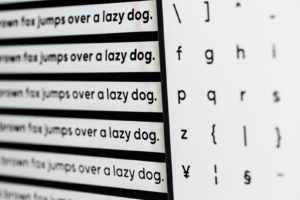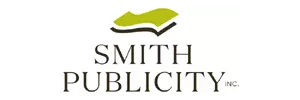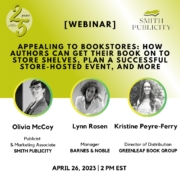Cover Your Back: Back Cover Blurbs
Back Cover Blurbs Can Help Sell Books

Conventional thinking assumes the book is on display in a physical bookstore. A reader is attracted by the title and cover text (or by the name of a known author). After picking up the book, he reads the back cover and is hopefully encouraged to sample a few pages and make a purchase. This model works fine except that in contemporary publishing, the majority of books are never displayed in a bookstore.
Given the popularity of e-Books, many back cover blurbs will never be displayed on a cover. In e-Book stores, the cover art is relegated to a tiny corner at the upper left of the page. However, the blurb, used initially as a bridge between the cover imagery and the book’s interior, is now the most significant, most important, and easiest to access the source of information. Deprived of its traditional context within a visual environment, the cover blurb must work harder and with less support than it did in the days of print.
Therefore, it presents new challenges: copy designed to be read online is loaded with relevant keywords that search engines can index. Writing compelling on-screen text introduces considerations that are not necessarily in harmony with the requirements of engaging, repetition-free writing. If you’re traditionally published, your publisher or publicist will have a clear idea of how to position your book. In most cases, publishers choose book cover art and write back cover text that supports proven merchandising strategies. Authors typically have little to say about the matter.
It suggests that if you’re still reading this, your book is probably independently published and unlikely to be found in a bookstore display. Traditional recipes work to the extent that prospective book buyers might find that approach comforting and familiar. Still, consideration of your book’s selling environment, your publishing goals, and the needs of your reader reveal more effective strategies.
Back Cover Blurbs — Why Are You Publishing?

Are you an artist who wants to share or a publisher who wants to sell? The two are not mutually exclusive, but be honest with yourself about whether you’re selling literary art or an intellectual/entertainment commodity. Well-crafted books don’t necessarily make the right products, and top-selling books aren’t necessarily well written.
Being realistic about your publishing goals is essential because the principal purpose of the back cover text is to let the reader know what to expect from the book. The cover blurb explains why she should part with twenty dollars and invest ten hours of her life taking in what you have to say.
Non-fiction writers usually have a clear idea of who their target reader is and what needs they anticipate the book will serve. They know precisely what the book’s value proposition is for you, the reader; you’ll learn how to write JavaScript code, develop a better understanding of Wall Street, or prep for your certification—practical stuff.
People who buy fiction are looking for an aesthetic experience. They may like romance novels or vampire books, or they may enjoy books about a particular period. But when the product is entertainment, the value of the book becomes more difficult to quantify. It’s easy to justify the cost of a book that teaches you a skill for which you can charge a fee, but a novel is like a movie; the experience has to be worth the cost of admission.
If you’re unclear about “the takeaway” —your book’s value proposition—your cover blurb will likely be a mish-mash of factoids that fails to answer the question: why should I buy this book?
Back Cover Blurbs: Non-fiction/Education
People buy non-fiction books about PHP programming or divorce because they have specific, immediate problems to solve. A short introduction followed by a bulleted list is often useful:
The Big Example Bicycle Repair Cookbook
Written by a veteran bicycle mechanic and illustrated with hundreds of detailed, color photos, The Big Example Bicycle Repair Cookbook is your ultimate reference to dozens of maintenance and upgrade tasks. Each repair is presented in recipe format where tools, materials, options, and any prerequisite skills are displayed along with step-by-step instructions. Whether you’re an amateur rider who wants to tackle basic maintenance or a pro mechanic, The Big Example Bicycle Repair Cookbook is the last bicycle book you’ll ever need.
- Learn about and lubricate six common friction points that reduce speed and cause wear
- Get more mileage out of tires and brakes with two simple adjustments.
- Adjust your seat and handlebars to improve riding efficiency by up to 25%.
- Overcome your natural fear of doing it yourself.
This back cover blurb explains exactly who the book is for, what the reader can expect to get out of it, and why the book is an excellent alternative to similar resources. Notice the call-to-action words in the bullet points: learn, get, adjust, overcome. This blurb also establishes credibility for the author, “a veteran bicycle mechanic.”
Back Cover Blurbs: Genre Fiction
Night of the Example Zombies
Next week, Becky plans to graduate college, start her new career, and get married to Nick—until an unexpected encounter turns her life upside-down. Becky has seen her share of horror movies, but nothing prepared her to confront real-life zombies who play by rules Hollywood’s never heard of. Now, survival depends on solving an impossible riddle, uncovering a dark secret, and convincing Nick she’s not crazy—before it’s too late.
Night of the Example Zombies Book is an exciting twist—full of spattered gore, fast-moving thrills, and a maze of clever clues and conundrums that are sure to keep you turning pages late into the night. In this, her second novel, Jenny Smith, proves there’s plenty of rotten blood left to squeeze from the zombie genre.
This blurb surely conveys my ignorance of zombie books, but it offers a synopsis of the plot. It tells the reader to expect the book to be different from other books in the genre, and it makes the deliverable explicit—thrills and entertainment. It also drops the author’s name, suggesting that the reader should know it. And though we hope the book is well written, it’s not presented as a candidate for a Nobel Prize in literature. This is fast, light reading that does not pretend to be otherwise. At the same time, we know this isn’t Smith’s first book; she’s not a rookie at the writing game, and this (hopefully) inspires confidence.
This blurb is short enough to allow the addition of a short testimonial or author biography, but consider that like great design, excellent writing is a process of subtraction. “Jenny Smith lives in Dubuque, Iowa with her husband, two children, and three Great Danes” will probably not help persuade more would-be readers to buy a book. Similarly, testimonials by the writer’s friends assuring the reader that “this book is a great read” are also likely to clutter and dilute a strong introduction. Fluff doesn’t belong on your back cover any more than it belongs in your prose.
Back Cover Blurbs: Historical & Literary Fiction
Some authors create “book products” designed to be sold to a specific audience. These books are conceived as products for sale. Other writers are more concerned with creating an excellent book—whether or not they ever sell a single copy. But after working with professional editors and designers, some self-publishers equate “good” with “marketable.” They spend a great deal of time, money, and energy trying to sell art.
Art does sell—and sometimes it sells for a tidy sum—but it is not the star around which the planets of the publishing industry rotate. With a polished manuscript in hand, it’s easy to imagine your book as a retail success story. But such dreams often lead to book designs and cover text that imitates the commercial feel of a trade published novel. A back cover blurb is a form of advertising; a commercial aesthetic may very well diminish the prospective reader’s perception that your book is art.
For purposes of this discussion, consider scholarship also to be an art form. Historical novels and documentaries appeal to niche readers interested in history and literature. Though this niche is potentially large enough to be thought of as a “market (depending on what the particular subject of that history and literature is),” these readers tend to be smart, educated, and discriminating. Offer historical fiction and literary nonfiction with the same matter-of-fact, honest, down-to-business attitude that you would use to describe a postmodernist art novel.
And if your book is not going to appear on a mainstream bookstore display table, consider publishing a hardcover book with all of the text (and the barcode too, please) moved to the inside jacket flaps. If the cover is provocative, uncluttered, and free from blah blah blah, it will wrap your book in art, wordlessly conveying the message that the book, itself, is art. Paperbacks are a commercial product produced and shipped at a lower cost. If your book is literary art, don’t make it look like a retail product. Big publishers honor their new offerings by introducing them in hardcover format.
For the blurb, consider what readers want from literary art—masterful use of language, original research, authentic descriptions, unique interpretations, deep insights, great perspectives, honesty, innovation, creativity. Art lovers want something to marvel at; their tastes are as varied as the world’s selection of art. Your blurb should concisely describe the art and the artist without attempting to advertise or sell. Quite often, the impact of art is best judged by reading the faces of its observers. A quick synopsis followed by a selection of testimonials qualifies the book against the would-be reader’s interests and suggests that it already has a discerning and appreciative audience.
Example Historical and Literary Fiction
Set in Massachusetts during the time of the American Revolution, Example Hist Lit Fic follows the oddly intertwined lives of an African slave, a Narragansett Indian, and the daughter of a New England Whaling Captain. Thoroughly researched and rendered in stark, powerful strokes of prose, Stirling describes a young America struggling to balance its Christian values against the allures of abundant natural resources and endless territory while conflict with England looms on the horizon. Example Hist Lit Fic is an authentic depiction of early American life that boldly exposes the roots of the contemporary human condition.
Stirling’s prose is masterful. His characters are authentic and engaging. Example Hist Lit Fic is a dark voyage through history and human nature, but also a hopeful and inspiring tour of the human spirit.
—Example Reviewer 1, Professor of History at Prestige University
Example Hist Lit Fic is both a captivating story and a much-needed setting straight of the historical record. Stirling proves himself as a tell-all researcher, a master wordsmith, and an insightful visionary.
—Example Reviewer 2, Historical Director, XYZ Museum
Geoff Stirling teaches American History at Fictional University in Fictiontown, Massachusetts. Example Hist Lit Fic is his third novel.
This blurb spends little time trying to describe the plot or characters. It spends no time at all trying to sell the book to Joe Every reader. It informs us about the book’s historical context and suggests the reader will value its historical accuracy and well-crafted prose. Probably, this is neither light nor easy reading; readers of popular books may find it too sophisticated for their palettes. But for those who enjoy a deep dive into history or literature, the description will be enticing. Implied is unquestionable integrity; the author is not trying to sell millions of books. His obvious goal is to present this book to those readers who will most appreciate it. The testimonials are of particular value here because credentialed, respected sources offer them. Rather than provide fluffy praise for “a great book,” their remarks address specific strengths that are likely to appeal to the reader. The comments suggest that this book is valuable and essential.
Back Cover Blurbs: Memoir and Biography
Good memoirists don’t write books because they want to monologue about themselves for 400 pages. Successful biographies and memoirs translate the real-life experiences of real-life people into lessons, inspiration, and entertainment.
The memoir/bio cover blurb introduces the subject character, summarizes relevant life experiences, and explains why the reader will find those experiences valuable and pertinent to their own lives.
Example Bio
Joss Nonfic grew up in a small coal-mining town in rural Pennsylvania. He left high school to work in the mines and then lied about his age to “escape” to a U.S. Navy destroyer in the Atlantic, his first time seeing the ocean. Torpedoed by a German sub, Nonfic spent a week in a leaky life raft before landing at night on a beach in Europe. Hiding from the Nazis in occupied France, he was forced to place his trust and confidence in the most unlikely of friends.
Example Bio is a true story of adventure, heroism, survival, and bravery that crosses enemy lines to expose the darker and lighter sides of a war.
The protagonist’s story certainly sounds interesting, but what he’s selling is perspective, not personal catharsis. The story is a vehicle for something more significant than the history of the people and events it describes—something worth reading and thinking about.
Writing the Back Cover Blurb –Who? What? When? Where? Why?
How does one go about boiling the plot, characters, and value proposition of a book into a few paragraphs? Here are a few tips and techniques:
Start with basic questions (feel free to include how?) and make a list of answers:
- Who is the reader? (Age, gender, profession, demographics, psychographics)
- Who is the author? (Experience, credentials, background, other books written)
- Who are similar authors? (If they like Steven King, will they like your book?)
- What can the reader expect to get out of your book? (The value proposition)
- What is the book’s genre or category?
- When does the story take place?
- If, when is now, is your book the most current and up-to-date?
- When will the reader see results if he takes your book’s advice?
- Where does the story take place, or what region does it cover? Is the book intended for readers in a particular geographical area?
- Why is this book different from/better than the other one million books published this year?
- Why should the reader consider you or your book as a trusted source of information or entertainment?
The list goes on, and there’s plenty of overlap between questions, but a focusing exercise that anticipates readers’ questions is the first step toward answering them successfully. A successful back cover text is the result of a careful balance between the needs of the publisher and the needs of the reader.
Writing the Back Cover Blurb: Tips and Tricks
The Book Industry Study Group offers 51 significant subjects for books. The “Fiction” category alone is broken down into 140 sub-genres—that’s a lot of book categories! Try a web search for category codes appropriate to your book and then see what other publishers have done to appeal to your reader groups. Whether you choose to be inspired by them or to distance yourself from their copywriting techniques, you’ll find useful reference points and ideas worth considering.
Here are a few more cover blurb tips:
- Think carefully about your book’s target audience. Don’t try to sell mass-market fiction to literature snobs and don’t try to sell haughty prose to readers who eat pulp novels for lunch.
- Keep the cover blurb as “short and sweet” as possible. The longer it is, the less likely it is to be read. (See next tip)
- Make the cover blurb interesting and engaging. The more exciting and engaging it is, the more likely it is to be read—even if it’s too long. (See the previous tip)
- Typos and style errors in your cover blurb are a dead giveaway that you don’t care, and your book isn’t worth reading. From the standpoint of technical accuracy, the blurb is a pass/fail spelling and grammar assignment.
- Make sure your prospective reader knows what she can expect to get from your book in exchange for her investment in time and money. Whether the benefits are aesthetic or practical, every book blurb should offer a clearly stated value proposition.
- If your book is not a commercial product, don’t turn the back of it into a billboard.
- Praising your book is arrogant and narcissistic. Use testimonials—ideally real ones from credible sources—and make sure those testimonials address substantive strengths and value.
- There’s no shame in being too close to your book to write a compelling back cover; their authors do not write the blurbs on many trade-published book blurbs. If you’re stuck, ask someone else to read your book and write your blurb.
- Take the temperature of every word in your blurb. If it isn’t smoking hot, it had better be performing a useful function. Otherwise, it’s fluff; cut it.
- Make a shortlist of words and phrases that describe your book: funny, charming, intellectual, provocative, tragic, important, inspiring, etc.
- Make a shortlist of words and phrases that describe your expected readers: smart, over 50, female, college-educated, loves history, reads Victorian Sea Novels, read all the Harry Potter books, wants new web design skills.
- Connect the dots between the two lists.
Avoid formulas and recipes. There are as many approaches to writing your back cover blurb as there are writers and books. Think carefully about your publishing goals, your reader audience, and your book’s commercial potential and positioning. Above all, consider the importance of making your blurb engaging, informative, correct, and compelling. The success of your book marketing may rest on the shoulders of these few, short paragraphs.
By Dave Bricker
Dave Bricker, MFA is a publishing consultant and a professor of graphic design in Miami, Florida. He designs rich, experiential websites, creates beautiful book covers and produces classic book typography. His popular blog – http://www.
Dave Bricker is the author of The Dance, Waves, The One-Hour Guide to Self-Publishing, and The Blue Monk, a colorful memoir of his solo sailing experiences.
He is currently working on a magic e-Book formula that marries design and technology in unique and engaging ways.





